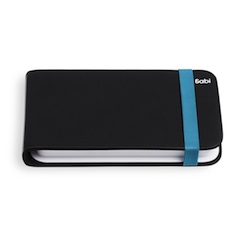Start-up designs hip health gear for aging Baby Boomers

NEW YORK--Canal Street in Manhattan's Chinatown is known for its peddlers of faux designer handbags and watches, but in the midst of this scene, on the corner of Canal and Broadway, sits a design studio known for its highly original products. On this corner you'll find the all-white, ultra-sleek New York office of fuseproject, the award-winning firm founded by Swiss-born, San Francisco-based designer Yves Behar.
It's a blustery January day, and he's sitting in the studio's conference room, behind a large table displaying a series of simple, white plastic jars with blue plastic lids and what look like black notebooks. Only they're not gym water bottles or writing pads, as they appear to be: the cylindrical containers have caps outfitted with secret compartments to store pills in, and the notebooks are actually pill cases for a week's worth of medications.
Behar is seated beside one of fuseproject's newest collaborators, Assaf Wand, a Palo Alto-based entrepreneur and McKinsey alum who founded Sabi, a start-up with a goal to create hip-looking, yet ergonomic and easy-to-use pill storage gear and other wellness and health-related gadgets. Their target audience is aging Baby Boomers who don't want to be stigmatized because they need to take medicine for various age-related ailments.
"In any other context beyond age, 'senior' is a compliment--think of 'senior designer,' 'senior management," Wand said.
STYLISH, SIMPLE, SAFE

Sabi's first products, which launched on Sabi.com on January 19, are designed to be discreet and simple to open, even with an ailment such as arthritis. The stylish wood-grain pattern on the lids of some Sabi pill containers provides a non-obvious grip, so that weak hands can better grasp a bottle. The bright blue accents point to where to open a case or a jar. And the shapes of the lids not only look pretty, but also are carefully calibrated at angles that allow them to be opened with a simple flick of the thumb, rather than a painful twist of the wrist. The debut line of Sabi products also features a patented pill cutter that doesn't require a dangerous blade, but instead can split tablets by leveraging a user's hand and weight pressure on the device, and a pill smasher that does the same.
The products, made with BPA-free and medical-grade, antibacterial plastic, range in price from $5.99 for a simple rectangular clip-on case to $29.99 for the notebook-look-alike pill organizer.
By late 2012, Behar and Wand said, Sabi will release two more product lines: one that offers products to help with lifting, carrying, and using everyday objects at home, and another that offers travel accessories.
"Every time I see a cool cane, I think, maybe I should just buy it now," Behar said. "It's not just because I'm going to get old one day, but I could have a surfing accident. You could have these health needs at any stage of your life. But there's no brand out there focused on the daily and weekly needs of someone who takes many medications or has other health needs, with containers and products that don't carry a stigma that the user is sick or handicapped."
So fuseproject and Sabi conducted online research with about 6,000 people online, Behar said, and brainstormed on hundreds of concepts that would meet stylish Boomers' ergonomic, organizational, and aesthetic requirements. They wanted the line to be affordable, so fuseproject designed the containers to be very streamlined, so they are manufactured to have only one or two snap-together plastic parts. They're packaged without shrink wrap and other complicated plastics that users might fumble with, too.
The story behind the Sabi concept echoes that of the OXO Good Grips line of ergonomic kitchen and other household gadgets, which OXO founder Sam Farber came up with after watching his arthritic wife struggle with a potato peeler. In fact, Wand said he was moved to create Sabi after observing both his wife's and his mother's needs--in Wand's case, his spouse's search for elegant, easy-to-open pill cases where she could subtly store prenatal vitamins while pregnant, and his mom's quest for the same for her own medications.
BOOMERS AND BEYOND
If OXO's success is any indicator of the potential of Sabi's viability, the picture is rosy. OXO went on to design more than 850 products and expand into new markets such as children's items. People of all stages of life and physical ability purchase OXO Good Grips gear because of their reputation of creating utensils that are comfortable to use. According to OXO, the company's total sales have seen an annual growth rate of 27% between 1991 and 2009.
And a December 2011 report from Boston Consulting Group estimated that the U.S. market for products and services for people age 65 and above is $1.4 trillion, poised to grow as 50% of the U.S. population will be age 55 or older by 2032.
These promising figures aside, Sabi could see sales from customers outside of its target demographic. The slick-looking water bottle with a hidden compartment for pills, for example, could easily appeal to a style-conscious gym-goer in his 30s, who wants to carry vitamin supplements with him to take after working out, or a 40-something who snowboards on weekends and gets hurt, requiring pain medication.
"When you're a certain age, you're supposed to accept horrible-looking products that come out of a hospital dispensary. They seem designed to suggest, 'you're not important,'" said Behar. "But people--whether they're older and taking heart medicine or young and injured--continue living. Our goal was to not put people in a design camp that says 'you're sick.'"
Images: Sabi
Related on SmartPlanet:
How to design for tomorrow's elderly
Yves Behar: Improving kids' vision via eye-catching design
Yves Behar: Designers must 'put the sexy back' in green
This post was originally published on Smartplanet.com
